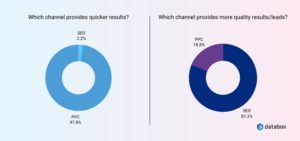In the competitive business world, growth is the lifeblood that keeps businesses thriving. Startups, in particular, face the challenge of determining the most effective strategy to fuel their growth.
Should they invest heavily in paid advertising to attract customers quickly?
OR
Is it wiser to focus on cultivating organic growth over time?
Today, we delve into this age-old debate and explore why a balanced approach might be the secret ingredient to success.
1. Paid Growth: The Race for Quick Results
Many startups turn to paid growth strategies in the quest for rapid expansion and revenue generation. By strategically investing in advertising, partnerships, and influencer collaborations, they can:
- Tap into new markets
- Increase brand awareness
- Drive revenue generation
A. Growth Hacking
Paid advertising enables startups to reach a wider audience quickly. They can generate immediate traction and increase website traffic by leveraging platforms such as Google Ads, Facebook Ads, or sponsored content. However, tracking performance and ensuring that the return on investment justifies the expenditure is crucial.
For instance, HypeFit, a fitness app. They created engaging video content showcasing their app’s features and benefits, resulting in a surge in downloads and registrations. This paid growth strategy increased their user base and attracted media attention. Thus resulting in organic growth through word-of-mouth referrals.
However, as the adage goes, “What comes fast, goes fast.” Paid growth can be a fleeting success, relying on continuous investment to maintain momentum.
2. Nurturing Organic Growth
“Organic growth is not about doing more. It’s about doing what matters most.”
Organic business growth relies on the following:
- Cultivating a strong foundation
- Building relationships
- Nurturing your customer base.

It emphasizes the significance of prioritizing impactful activities rather than chasing quick wins. Moreover, it focuses on cultivating a loyal customer base through methods such as:
- Content marketing
- Search Engine Optimization (SEO)
- Social media engagement
- Customer referrals
Now, organic growth may take longer to manifest. But it has several distinct advantages that make it invaluable to startups.
A. Long-Term Sustainability
Organic growth involves leveraging various channels. For instance, content marketing, SEO, social media engagement, and public relations. As a result, you can attract a steady stream of traffic and generate leads by:
- Providing valuable content
- Engaging with customers
- Optimizing your online presence
What more? It lays the foundation for a loyal customer base that continues to generate revenue. That, too, without constant ad spend.
B. Cost-Effectiveness
Organic growth might appear expensive due to the resources required. But the returns are far-reaching. Over time, these efforts lead to the following:
- Higher customer lifetime value
- Reduced customer acquisition costs
- Increased profitability.
C. Data Analysis & Tracking
Organic growth allows startups to gather valuable data and analyze performance metrics in detail. Using data analysis and tracking tools, they gain insights into customer behaviour, preferences, and pain points. This information provides a competitive edge in:
- Understanding their target market
- Optimizing marketing strategies
- Refining products or services.
One example of a brand successfully utilizing data analysis and tracking for organic growth is Netflix. Netflix is a streaming platform that offers subscribers a wide range of movies and TV shows.

Netflix heavily relies on data to understand the preferences and behaviour of its users. By tracking and analyzing data points such as viewing habits, search queries, ratings, and social media interactions, Netflix gains valuable insights into two things:
- What its users want to watch
- How do they engage with the platform
Using this data, Netflix can make data-driven decisions to:
- Optimize its content offerings
- Personalized recommendations
- Improve the overall user experience
Netflix also uses data analysis to inform its content creation and acquisition strategies. By analyzing viewing patterns and user feedback, Netflix can identify the following:
- Popular genres
- Emerging trends
- Untapped audience segments.
This insight enables them to invest in producing or acquiring original content that resonates with their user base, thus driving organic growth.

3. Striking a Balance
Look at these numbers. What do they suggest?

Rather than an either/or scenario, a hybrid approach combining both organic and paid growth strategies often yields the best results. By allocating resources intelligently, you can maximize your growth potential while minimizing risks.
For instance, Slack. When Slack launched, it focused on providing a superior product that spread through word-of-mouth. Its growth was predominantly organic, driven by satisfied users who referred the platform to others. This approach laid a solid foundation for the company, leading to substantial growth and ultimately attracting attention from larger organizations.
And let’s not forget Airbnb. In its early days, Airbnb used a combination of organic and paid strategies to grow its user base. It leveraged user-generated content and social media channels to organically engage with potential hosts and guests. As the company gained traction, it started investing in paid advertising to reach a wider audience, enhancing its growth trajectory.
What Do We Think?
In the realm of business growth, a one-size-fits-all solution doesn’t exist. While paid growth may offer quick wins, it lacks organic growth’s sustainability and long-term benefits.
Startups should prioritize laying a strong foundation through organic growth (80%) before complementing it with paid growth (20%). Businesses can achieve sustainable and profitable growth by balancing the two approaches and continuously analyzing data and performance.
Remember, growth is not just about numbers; it’s about building meaningful connections with customers, delivering value, and nurturing lasting success. And we at StartInc can help you strike just the right balance between organic and paid growth hacking. Even better, complement it with our experiential marketing strategies that will etch your brand and business in the minds of your consumers!
We understand. We consult. We execute. And we deliver.



